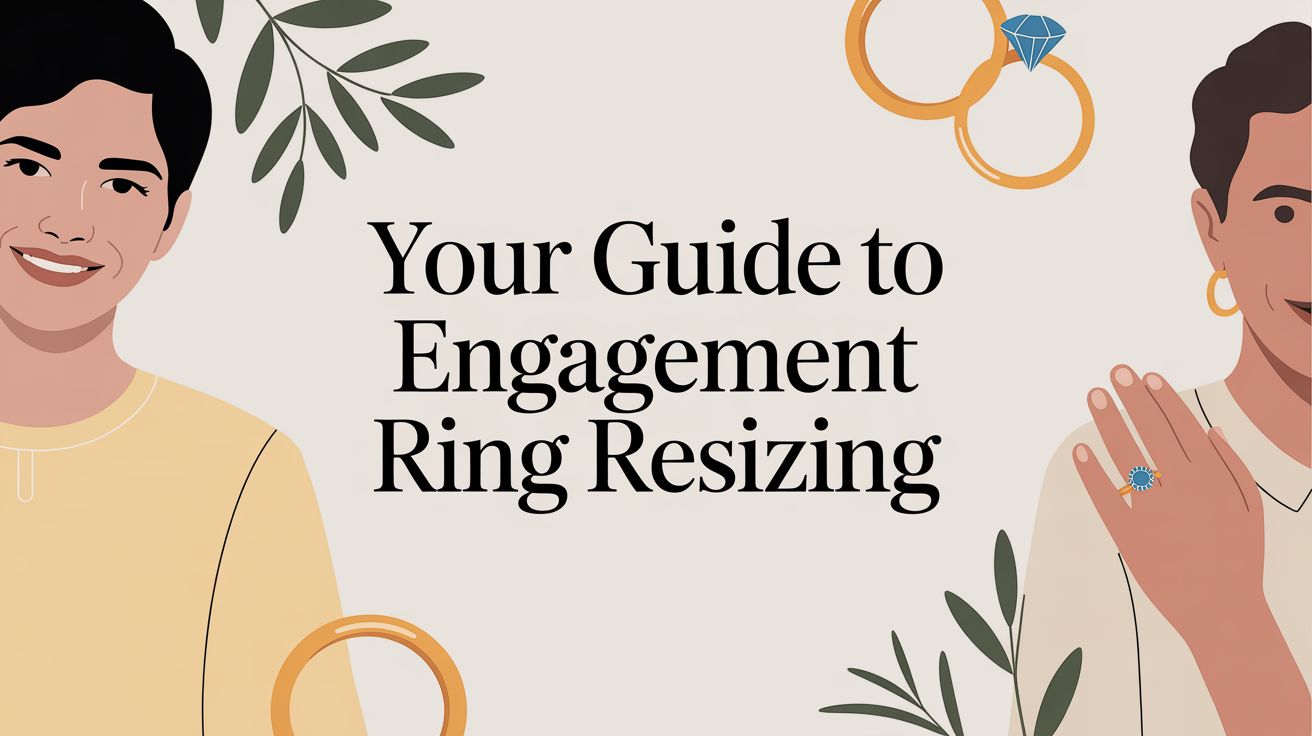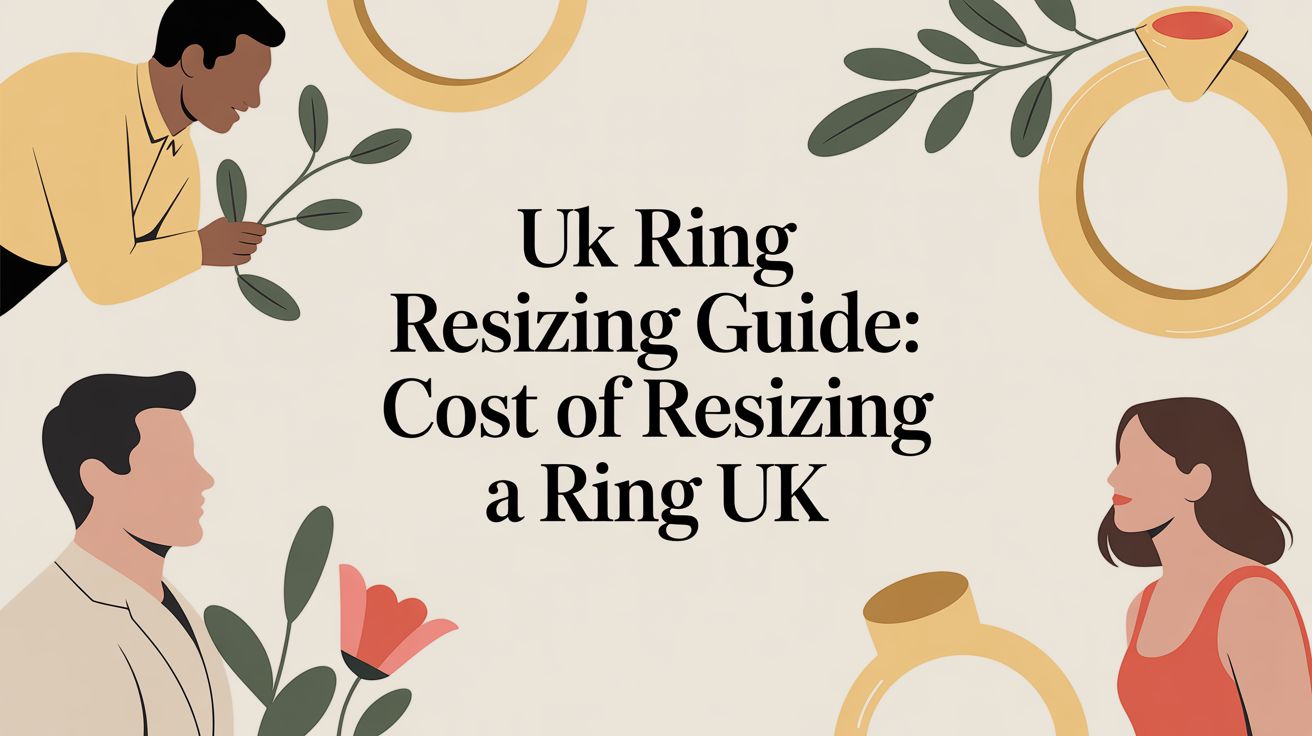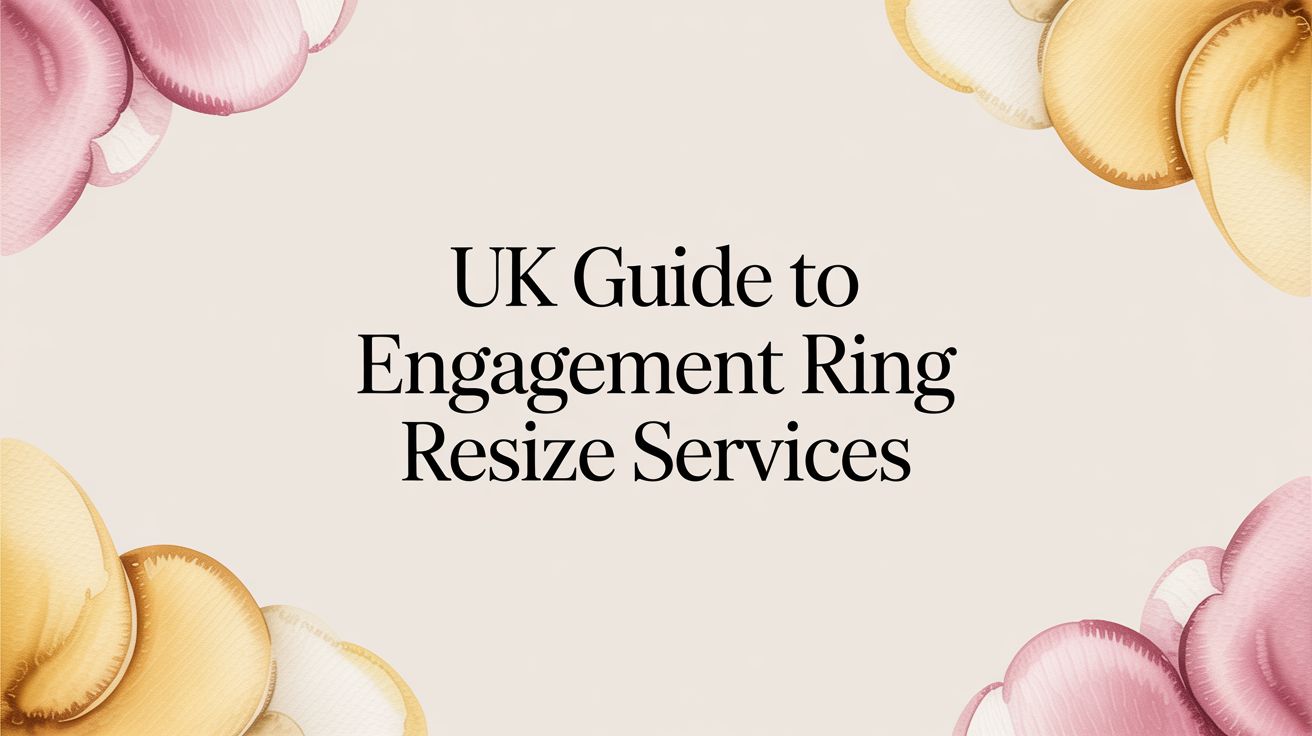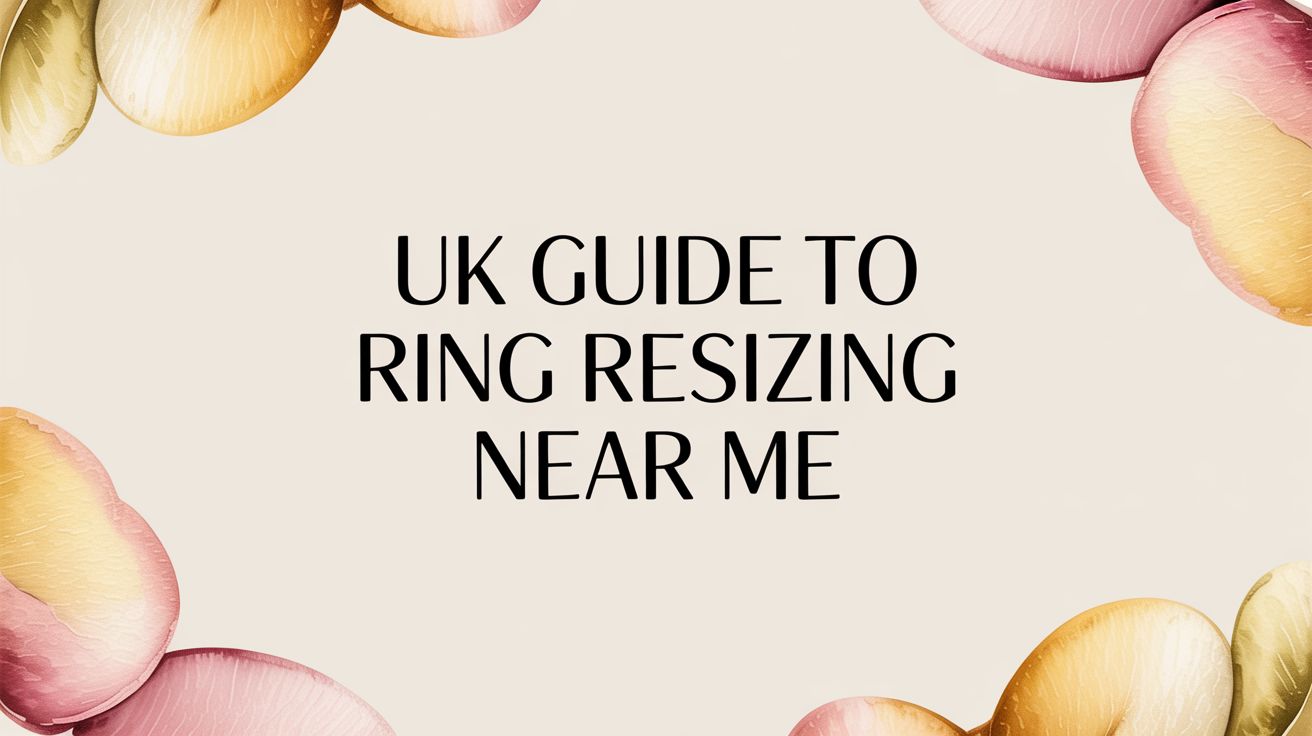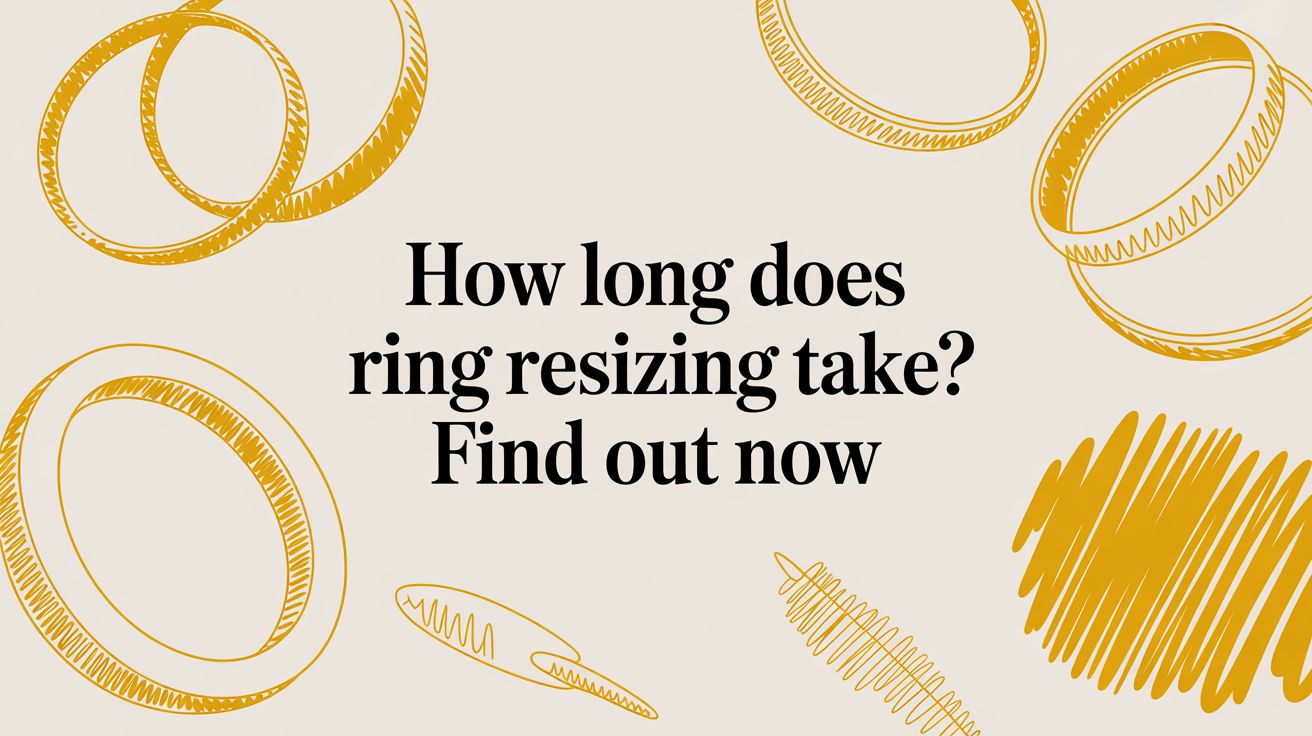That heart-sinking moment when your dream engagement ring doesn't quite slide on is incredibly common, but don't panic. Engagement ring resizing is a routine, safe, and effective procedure handled by skilled jewellers every day to make sure your cherished symbol of love fits perfectly. It’s not a flaw; it’s just the final step in personalising it for a lifetime of comfortable wear.
What To Do When Your Engagement Ring Doesn't Fit
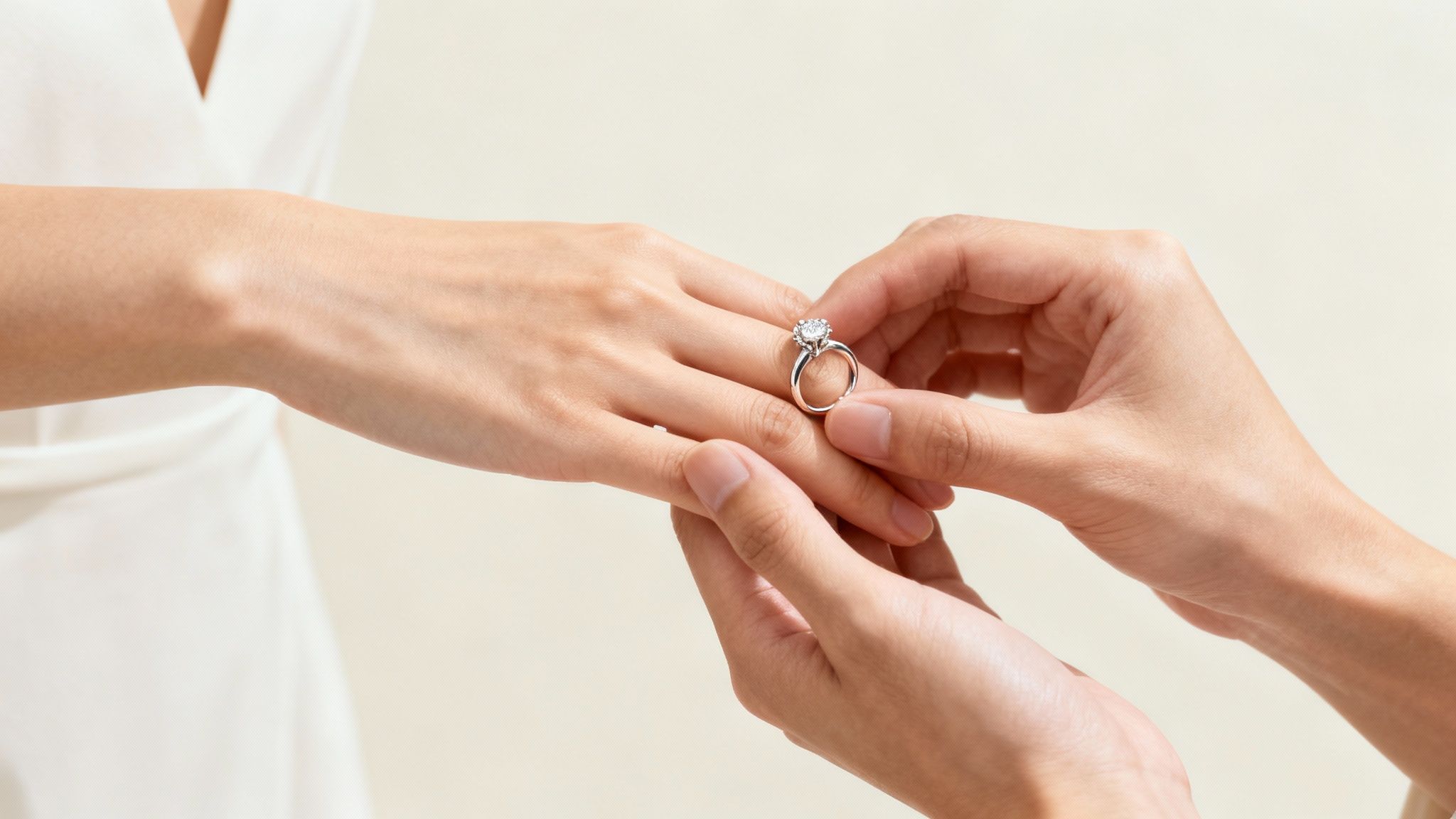
Discovering your engagement ring isn’t the perfect fit can feel a bit deflating, but it happens far more often than you’d think. Maybe it was a surprise proposal where the size was a well-intentioned guess, or perhaps it’s just down to natural changes in your body. Either way, an ill-fitting ring is a highly solvable problem.
The first step is to shift your perspective from worry to action. Realising that resizing is a standard part of the engagement journey helps ease any anxiety. Think of it like getting a suit tailored—it’s just a final tweak to get it just right.
In the UK, this is a familiar process for any experienced jeweller. In fact, some industry data suggests that approximately 70% of people who buy an engagement ring will need it resized at some point. It just goes to show how normal it is to need an adjustment.
Common Reasons a Ring Might Not Fit
There are several straightforward reasons why your ring's initial size might be off. Understanding them can help you feel more at ease with the whole situation.
- Surprise Proposals: Your partner likely made their best guess, maybe borrowing another of your rings or asking a friend for a steer. It’s a tough thing to get spot on!
- Seasonal Changes: It’s completely normal for fingers to swell slightly in warmer months and shrink in the cold, which can affect how a ring fits from one day to the next.
- Lifestyle Factors: Simple changes in diet, exercise, or weight can all lead to small fluctuations in your finger size over time.
A well-fitted ring should slide over your knuckle with a little bit of effort but then sit comfortably at the base of your finger without spinning or feeling tight. If you're constantly aware of it, it's time for an adjustment.
Ultimately, the most important thing is that your ring feels secure and comfortable on your hand. Before rushing to a decision, try wearing it for a few days to see how the fit feels at different times of the day.
Once you’re sure it needs an adjustment, the next step is finding a professional you can trust. You can explore options for a reliable ring resizing service near you to get the process started.
How To Find Your True Ring Size
Before a single tool touches your ring, the first job is to lock down your true ring size. This is more than just a quick wrap with a piece of string; getting an accurate measurement is the foundation for a perfect, comfortable fit. Rushing this part is the number one reason people end up back at the jeweller's for a second resize.
You’ve probably seen a few at-home methods, and while they can be a handy starting point, you need to know their limits. Printable ring sizers or the classic string-and-ruler trick can give you a rough idea, but they’re far from foolproof. Paper stretches, string can be pulled too tight, and both can easily lead you to the wrong size. Think of them as a ballpark figure, not the final word.
Mastering the Art of Timing
Believe it or not, your finger size changes throughout the day, and even with the seasons. To pin down a reliable measurement and avoid a ring that’s either strangling your finger or flying off, timing is everything.
- Measure in the Evening: Your fingers are naturally at their largest towards the end of the day. A measurement taken first thing in the morning is almost always too small.
- Avoid Temperature Extremes: Don’t measure when your hands are freezing cold (your fingers will be smaller) or right after a hot shower or a workout (they’ll be swollen). You want to measure when your body temperature is stable and you feel comfortable.
- Check It Three Times: For the most accurate result, measure your finger on three separate occasions, ideally at different times of the day, to find a consistent size.
The goal is a size that slides over your knuckle with a gentle push but then sits securely at the base of your finger without spinning. If you have larger knuckles, you might need a size that feels a tiny bit loose at the base just to make sure it can get on and off without a struggle.
Why a Professional Measurement Is Best
While home methods have their place, nothing beats the precision of a professional jeweller. They use calibrated metal ring sizers—the industry standard—for a precise reading that DIY methods simply can’t match.
A good jeweller will also factor in the design of your ring. For example, a wide band often needs to be a slightly larger size than a very thin one to feel comfortable. This kind of expert insight is invaluable.
It’s especially important with today’s jewellery trends. We’re seeing a huge demand for shaped wedding bands designed to sit perfectly flush against an engagement ring. In fact, UK sales for these styles jumped from 7% in 2023 to nearly 20% in 2024. This trend really underscores the need for dead-on sizing, so both rings fit together without rubbing or creating an awkward gap. You can see more about how engagement ring trends are evolving on Queensmith.co.uk.
Getting a professional measurement from the start just makes sense. It saves you time, guesswork, and the potential cost of another resize down the line. It’s the surest way to get that perfect, once-and-done fit.
The Jeweller's Process For Resizing Your Ring
Handing over a precious ring, especially an engagement ring, can feel a bit daunting. But knowing what actually happens in the workshop helps demystify the entire process. A professional jeweller’s work is a delicate balance of precision and artistry, designed to change your ring's size while leaving it looking completely untouched.
This decision tree gives you a great visual on that first step: figuring out whether to measure your size at home or trust it to a professional.
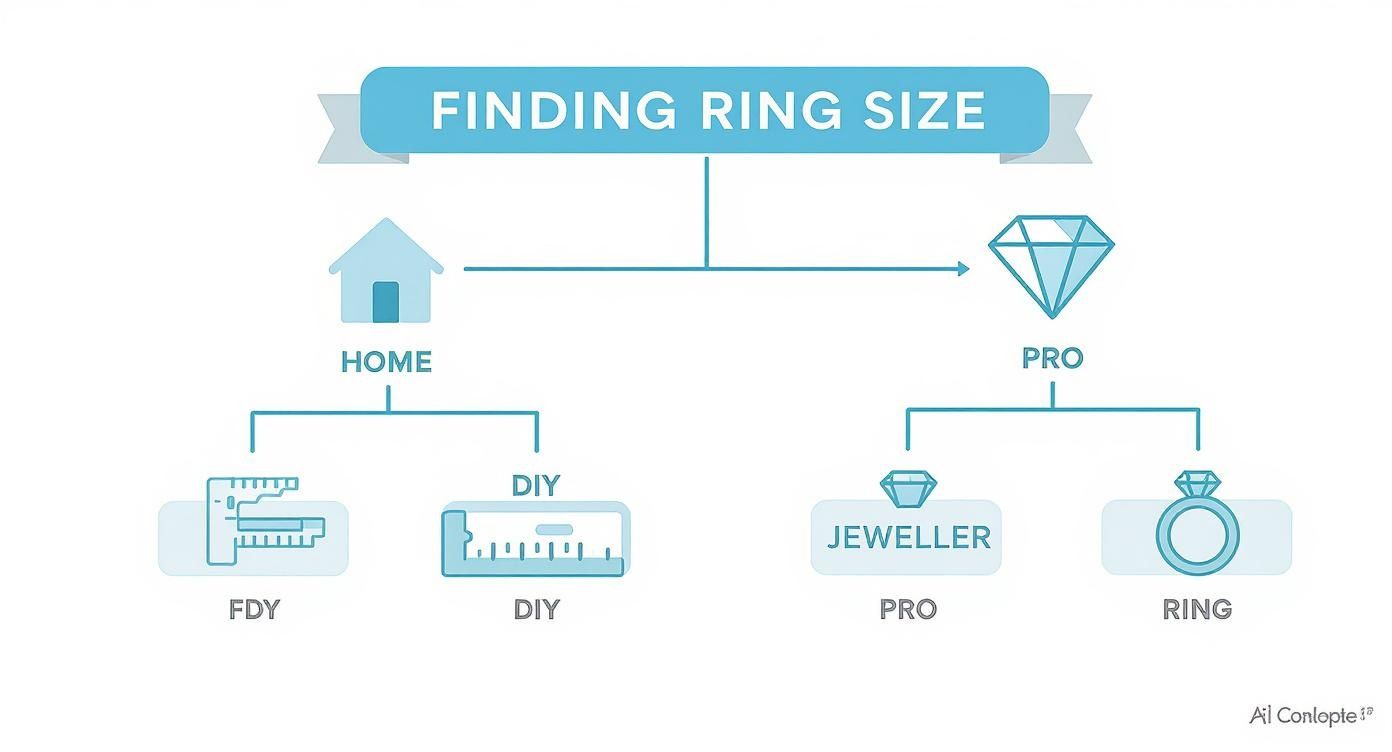
As you can see, while DIY methods are an option, the most reliable path to getting that perfect, accurate fit leads straight to a jeweller.
Making a Ring Smaller
If your ring is too loose, the fix is quite direct. A jeweller will carefully measure and cut out a tiny piece of metal from the bottom of the band (the shank). This is the part of the ring that sits underneath your finger, making it the least visible area for any work.
Once that small section is gone, the two ends are expertly brought back together. The jeweller then solders them shut using a metal that perfectly matches your ring's material—be it gold, platinum, or silver. The final, crucial steps involve cleaning, polishing, and refinishing the band to erase any trace of the work, restoring its original seamless shine.
Making a Ring Larger
Enlarging a ring usually involves one of two techniques, depending on how much bigger it needs to be. For a very small adjustment—often half a size or less—we can sometimes stretch the existing metal. This is done carefully on a special tool called a ring mandrel, which gently expands the band without compromising its strength.
If you need a more significant size increase, stretching just isn't an option as it thins and weakens the band. Instead, the jeweller will cut the shank and add a new piece of matching metal. This new piece is meticulously shaped and soldered into the gap. Just like with downsizing, the ring is then polished to perfection, ensuring the join is completely invisible.
A common worry is whether the resize will be visible. In the hands of a skilled jeweller, it absolutely should not be. The goal is always a flawless finish where the colour, shape, and polish are indistinguishable from the original ring.
To help you understand the options, here’s a quick comparison of the common resizing methods our goldsmiths use.
Comparing Ring Resizing Methods
| Method | Best For | Process Overview | Key Consideration |
|---|---|---|---|
| Cutting & Soldering | Sizing up or down more than half a size; most common method. | A small piece of the shank is removed (to size down) or a new piece is added (to size up). The band is then soldered and polished. | The most precise method for significant size changes. The join should be completely invisible when done by a professional. |
| Stretching | Sizing up by a small amount (typically 0.5 size or less) on plain metal bands. | The ring is placed on a ring mandrel and gently expanded under pressure until it reaches the target size. | Not suitable for rings with stones or intricate patterns, as it can distort the setting and thin the band. |
| Adding Sizing Beads | A temporary or minor adjustment for rings that are slightly too big or top-heavy. | Two small metal beads are soldered to the inside of the shank to create a snugger fit. | Great for arthritic knuckles or when a permanent resize isn't ideal. They can be removed later if needed. |
Ultimately, the best method depends entirely on your ring's design, metal, and the required adjustment, which a professional will assess during your consultation.
Protecting Your Ring's Details
A professional always takes extreme care to protect every part of your ring. This is especially important for delicate settings, intricate engravings, and of course, the diamonds themselves. Here’s what they do:
- Stone Protection: Gemstones are often sensitive to heat. Before soldering, a jeweller will apply a special heat-absorbing gel or use a laser welder, which focuses heat on a tiny point, keeping the stones safe and cool.
- Preserving Engravings: If your ring has an inscription, the jeweller will work around it. When a cut is necessary, it's always made at the plainest part of the shank to avoid disrupting the engraving.
- Maintaining Integrity: The soldering and finishing process is designed to be as strong as—or even stronger than—the original band, ensuring your ring remains durable for a lifetime.
Some workshops, particularly those in areas like London's Hatton Garden, offer specialised services that can speed things up. For those who can't bear to be without their ring for long, it's worth exploring the possibility of a while-you-wait ring resizing service, which can often be completed in a matter of hours.
When A Ring Cannot Be Resized
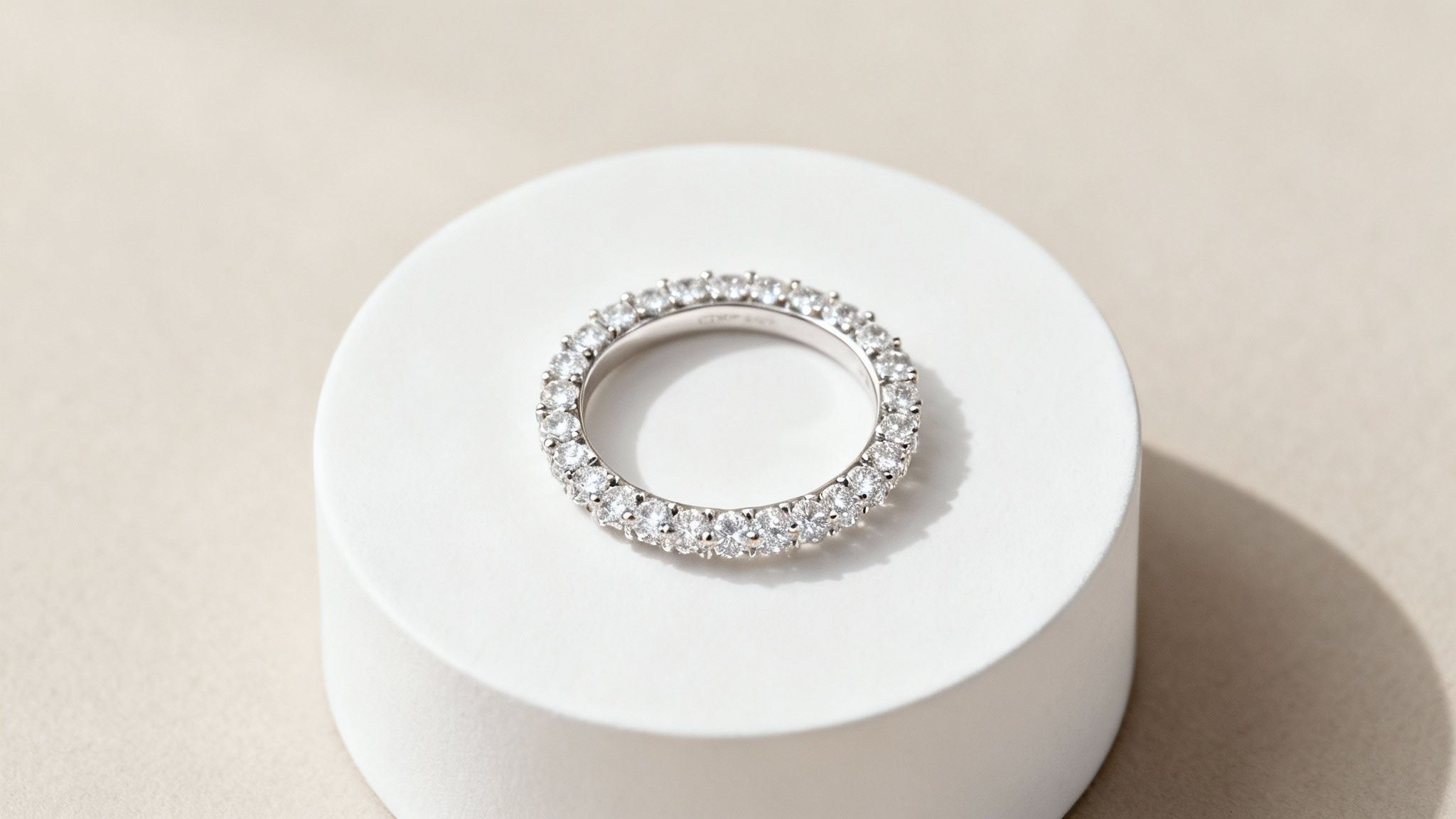
It’s a common misconception that every ring is fair game for resizing. While most gold and platinum bands can be adjusted with relative ease, certain metals and intricate designs create huge hurdles for a jeweller. In some cases, a traditional resize is completely impossible without compromising the ring's entire structure.
The main obstacle often comes down to the metal itself. Modern alternative metals are popular for their toughness, but that same durability makes them a nightmare to work with.
- Tungsten and Titanium: Prized for being incredibly hard and scratch-resistant, these metals can’t just be cut and soldered like gold. Any attempt to do so would likely shatter or permanently damage the ring.
- Stainless Steel: While not quite as hard as tungsten, steel’s high melting point and resistance to being worked make a standard resizing job incredibly difficult, if not impossible.
If your engagement ring is made from one of these metals, a classic cut-and-solder resize is simply off the table.
Designs That Resist Resizing
Beyond the metal, the ring's design is often the deciding factor. The more complex or continuous the pattern, the harder it is to alter without leaving a visible, structurally weak flaw. This is especially true for rings covered in gemstones.
Eternity bands are the perfect example. With a continuous row of stones, there’s no plain metal for a jeweller to safely cut into. Taking out a section would ruin the pattern and weaken the settings of the neighbouring gems, while adding a piece of metal would create an obvious, awkward gap.
Other challenging styles include:
- Channel-Set Rings: Here, stones are set flush inside a channel. Cutting the band can compromise the tension holding them secure, putting you at risk of losing diamonds.
- Tension-Set Rings: The ring’s entire structure works to hold the centre stone in place through pure pressure. Altering the band’s circumference would release that tension, and the stone would simply fall out.
- Intricate Engravings: When a pattern or engraving wraps around the entire band, resizing creates a blank spot where the jeweller has worked, interrupting the seamless design.
Just because your ring can't be resized in the traditional sense doesn't mean it's the end of the road. It just means we need a more creative solution. Skilled jewellers have clever methods to adjust the fit without ever cutting the band.
Practical Solutions for Non-Resizable Rings
So, you have a ring that can’t be cut and soldered. Don't worry—you still have some great options. These solutions work by changing how the ring fits internally, rather than altering the band itself.
One of the most popular and effective methods is adding sizing beads. A jeweller solders two tiny, smooth metal balls to the inside of the band. These beads grip your finger just enough to stop a loose ring from spinning, creating a much snugger fit. It's a fantastic semi-permanent fix that can be easily removed later if needed.
Another clever option is a spring insert. This is a small, U-shaped metal strip installed on the inside of the ring. It flexes to go over your knuckle, then springs back into place for a secure, comfortable fit at the base of your finger. It’s an ideal solution for people with larger knuckles.
Ring Resizing Costs And Timelines In The UK
Once you’ve decided to resize your ring, the next two questions are always the same: "how much is this going to cost?" and "how long will I be without it?"
Getting a clear picture of the costs and timelines here in the UK helps you plan and takes the stress out of the process. Let’s break it down.
The final price tag isn't a one-size-fits-all number; it really hinges on a few key things. The biggest factor is the metal your ring is made from. Platinum, for instance, has a much higher melting point than gold, meaning it demands specialist tools and more workshop time. That makes it more expensive to work on.
Likewise, a simple, plain band is a more straightforward job than a complex design loaded with intricate engravings or a whole gallery of stones.
Breaking Down The Costs
In the UK, a standard engagement ring resizing will typically set you back somewhere between £50 and £150. This bracket covers most common adjustments on gold or silver rings without too many complications.
Of course, certain things can push that price up:
- Metal Type: Resizing a platinum ring often starts closer to £90 and climbs from there. It's just a trickier metal to work with.
- Size Adjustment: A small jump of one size is going to be cheaper than a big leap of two or three sizes, which often means adding a whole new piece of metal.
- Complexity: Rings with pavé settings, channel-set diamonds, or detailed patterns demand a lot more labour. The goldsmith has to make sure every single stone is secure and the pattern remains flawless after the work is done.
The UK jewellery market is a big deal—valued at around USD 5.76 billion in 2024, with rings making up the largest slice. This means we have plenty of skilled artisans, but it also shows how valuable these pieces are. You can read more about the significance of rings in the UK market on diamondsbyuk.co.uk.
Understanding The Turnaround Time
Just like the cost, the time it takes to get your ring back can vary. For a simple resizing on a plain band, a good independent jeweller can often get it done within a few days to a week. If the workshop isn't too swamped, some might even offer a next-day service.
Be realistic with your expectations. A complex resizing job, especially on an intricate or valuable ring, is a delicate craft. Rushing the process is never a good idea, as it can compromise the quality and safety of your ring.
More complicated jobs, like resizing a detailed vintage ring or a band with stones all the way around, will naturally take longer. For these, a timeline of one to two weeks is much more realistic. This gives the jeweller the time they need to carefully make the adjustment, re-secure any stones, and meticulously polish the ring to bring it back to its original glory.
Our guide offers more detail on what to expect from ring resizing timelines. The best advice? Always ask for a clear timeframe upfront so you know exactly when you’ll have your ring back on your finger.
Common Ring Resizing Questions
It’s completely normal to have a few questions, even after you understand the basics of resizing. This is a precious piece of jewellery, after all. To give you total peace of mind, here are some straight answers to the queries we hear most often.
How many times can a ring be resized?
For most rings, resizing two or three times over its life is perfectly safe. Each time a ring is adjusted—whether up or down—it puts a little stress on the metal. Doing it too often can eventually weaken the band, particularly at the spot where it was soldered.
Softer metals like gold are generally more forgiving than tougher ones like platinum. A good jeweller will always inspect your ring first and give you an honest opinion on whether another resize is wise without risking its structural integrity.
The single most important factor is the quality of the work. A professional resize maintains the ring's strength, but a poor job can create a weak spot, making future adjustments a risky business.
Will resizing my ring damage or devalue it?
When done by an expert, resizing should be completely invisible and will not devalue your ring. A professional goldsmith's main goal is to preserve the ring’s original strength, beauty, and finish. The final result should be a seamless, perfectly polished band that looks like it was made in that size from day one.
This is where choosing the right person for the job is so important. A badly done resize can leave you with a visible seam, a slight colour mismatch in the metal, or even weakened stone settings. Any of these flaws could lower its value, which is why you should always find a trusted, experienced jeweller with a solid reputation.
Should I go back to my original jeweller?
If it's practical, yes—returning to the jeweller who sold or made the ring is usually the best first move. They’ll know its exact construction, the specific metal alloy used, and the nuances of its settings. Many jewellers also offer a complimentary first resize with purchase.
But if that's not an option—maybe you've moved, or the ring is a family heirloom—your next best bet is finding a reputable local jeweller with an on-site workshop. Don't be shy about asking to see examples of their work or enquiring about their experience with rings like yours. A confident craftsman will be happy to show you.
At Opulence Jewellery Services, our Hatton Garden workshop is run by master goldsmiths with over 15 years of experience. We use the latest technology to handle every resize with precision, ensuring your cherished ring is returned to you fitting perfectly and looking flawless. Find out more about our expert ring resizing and repair services.
